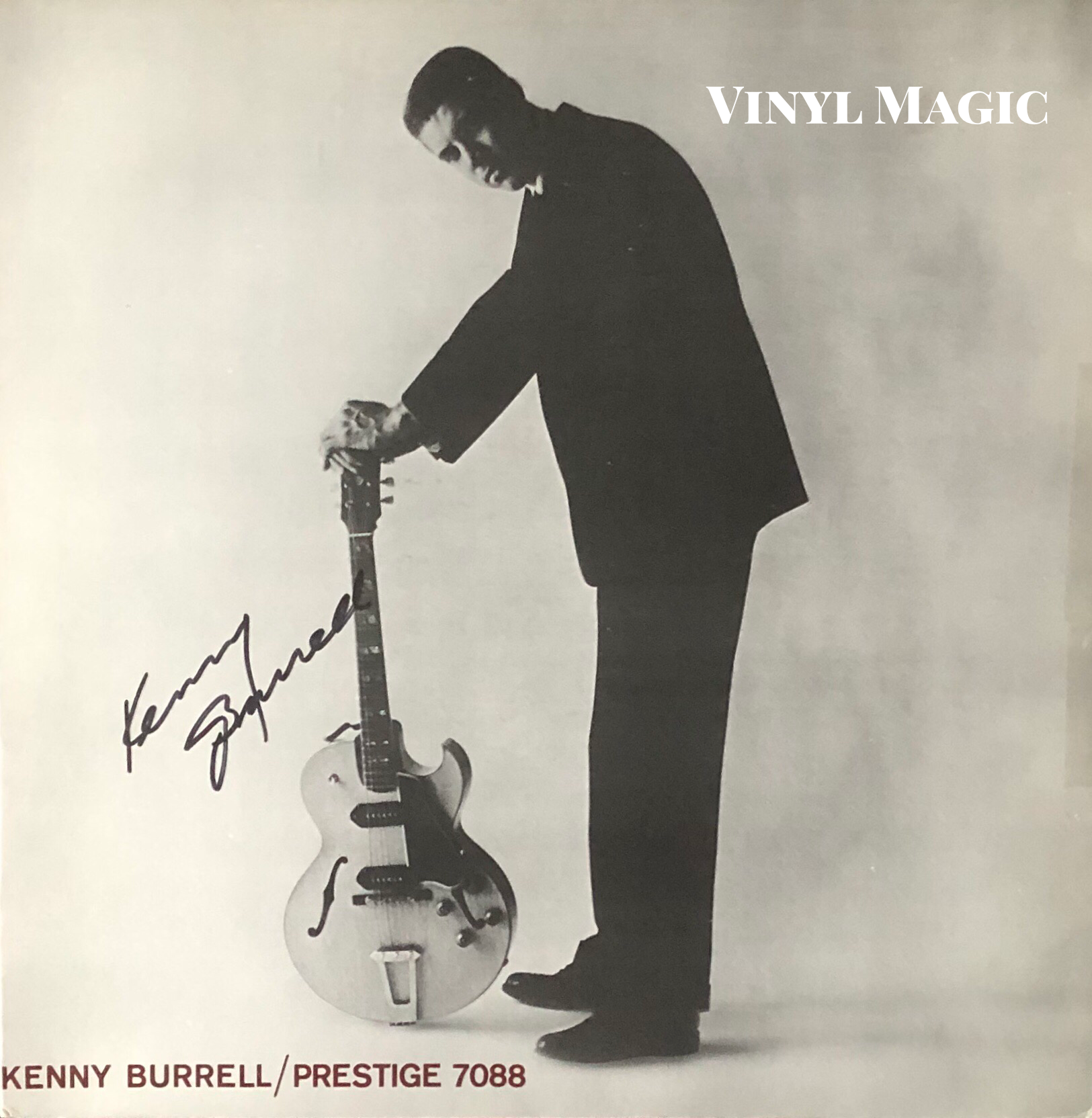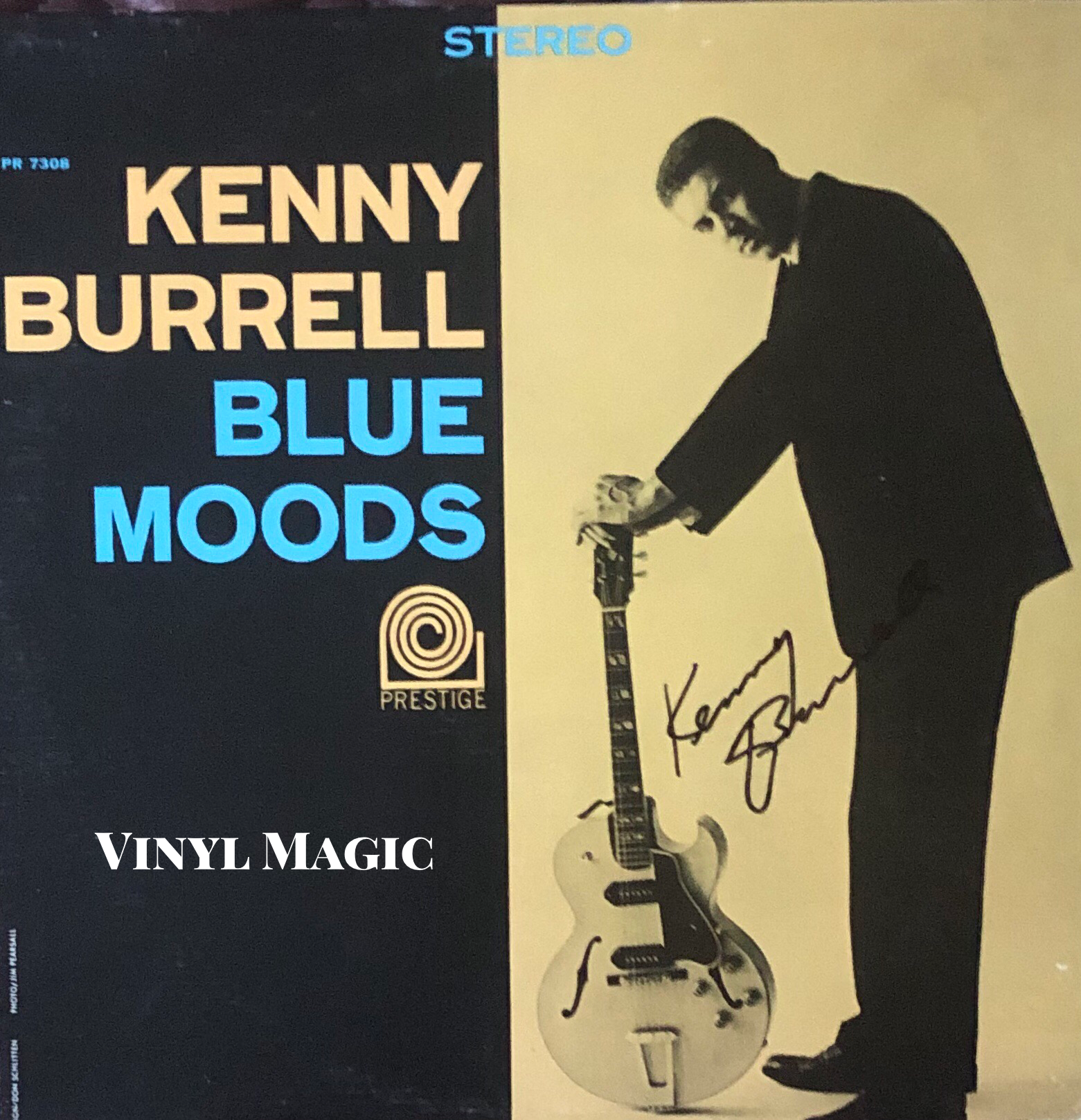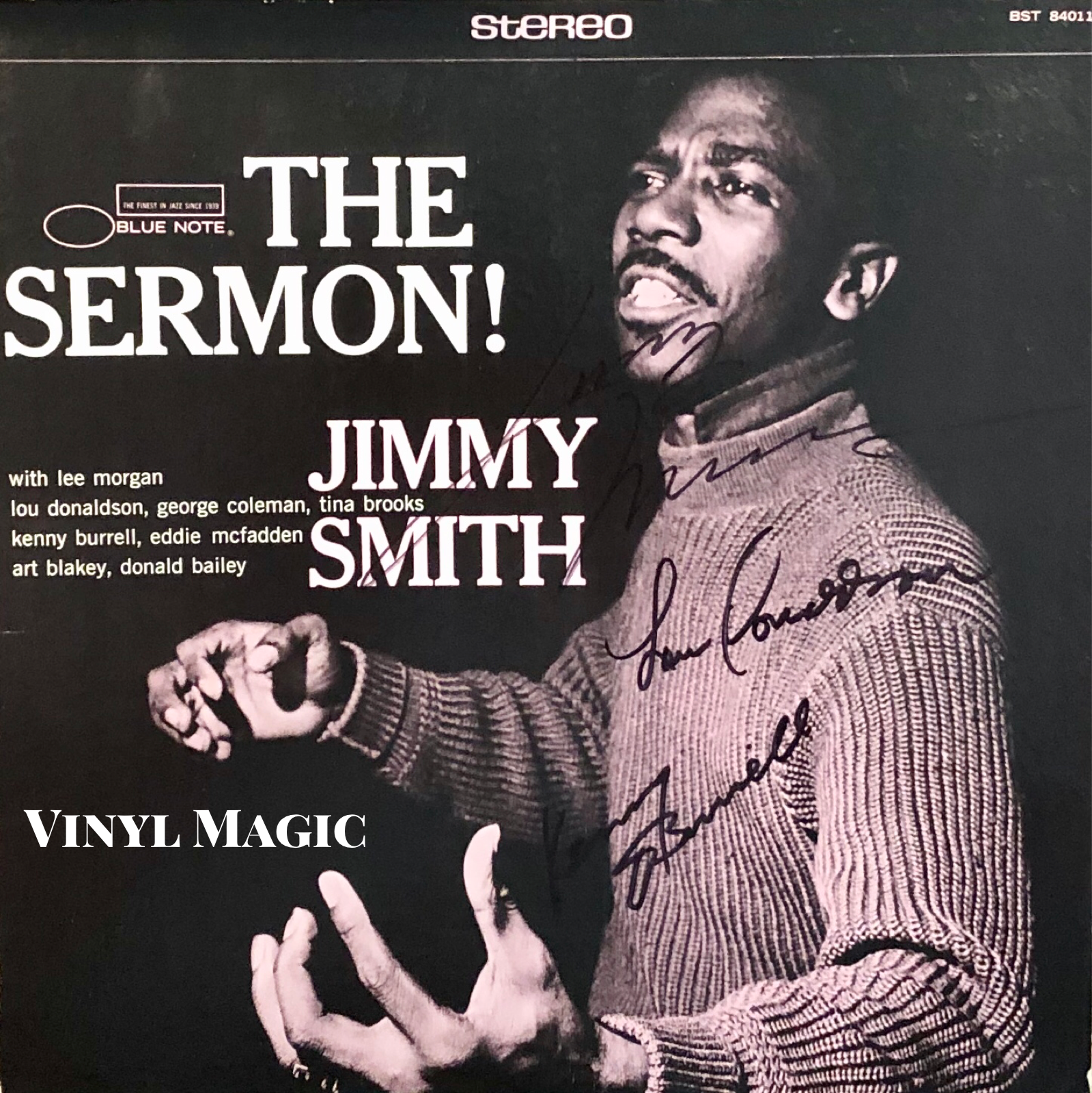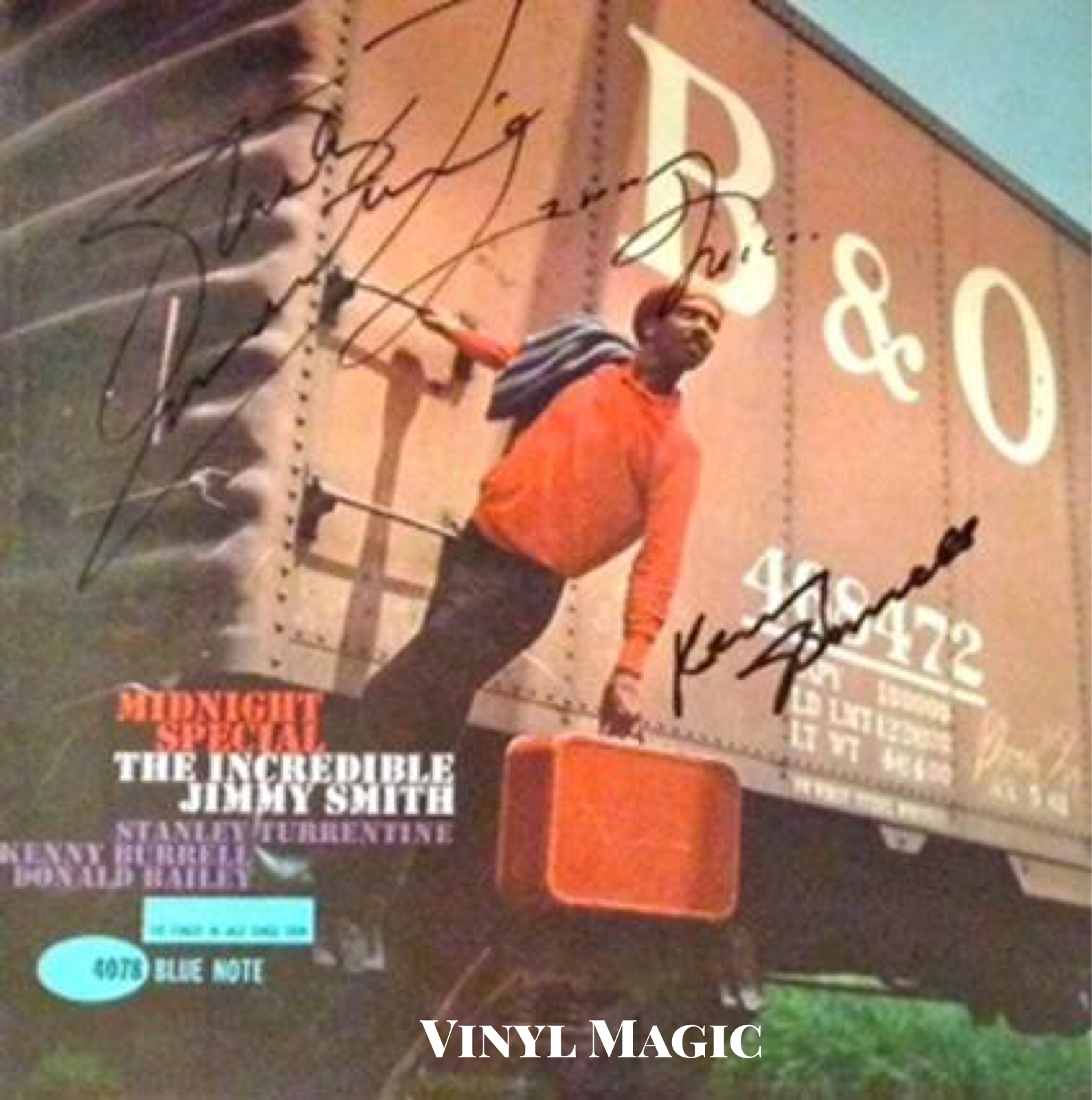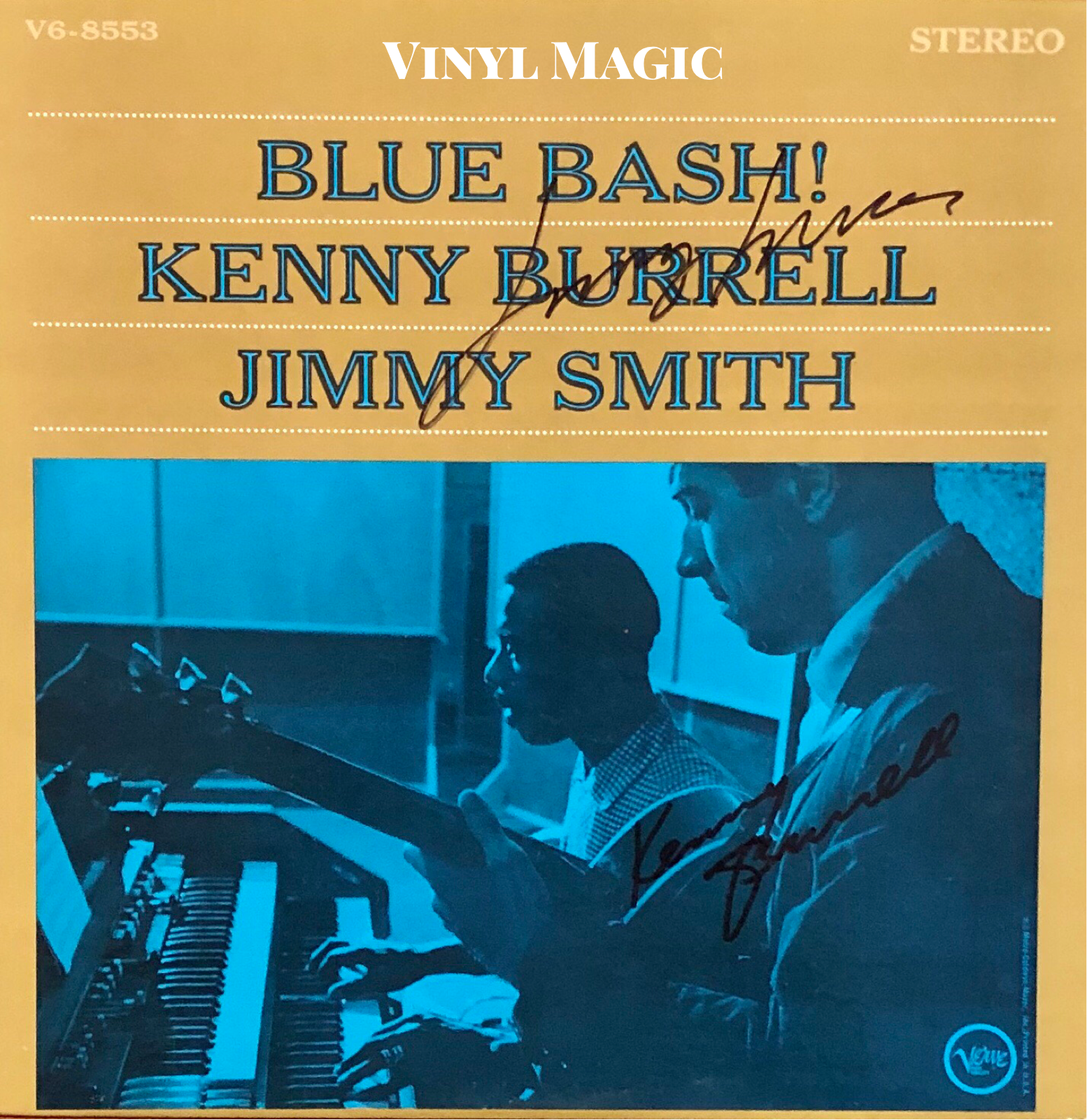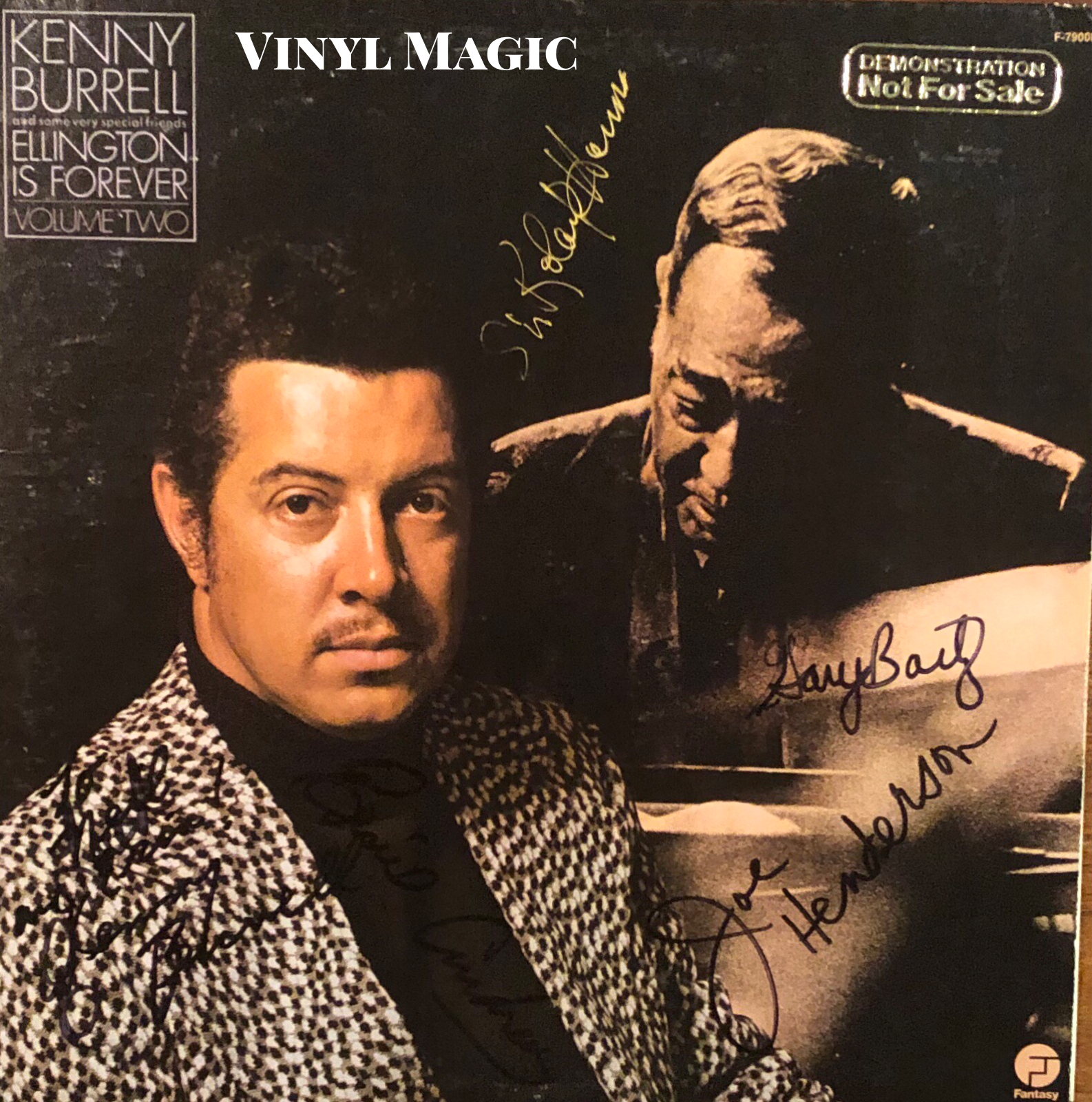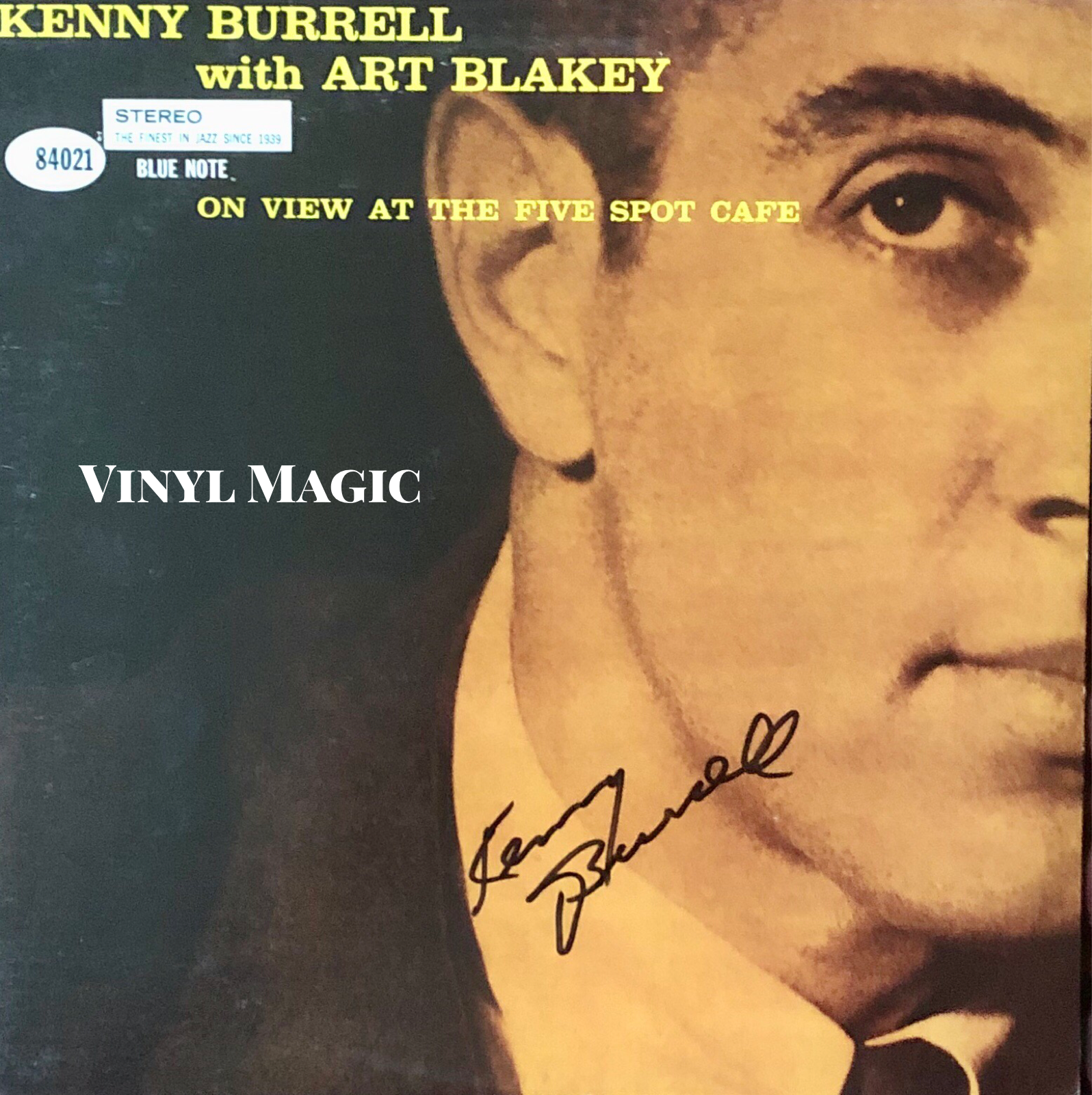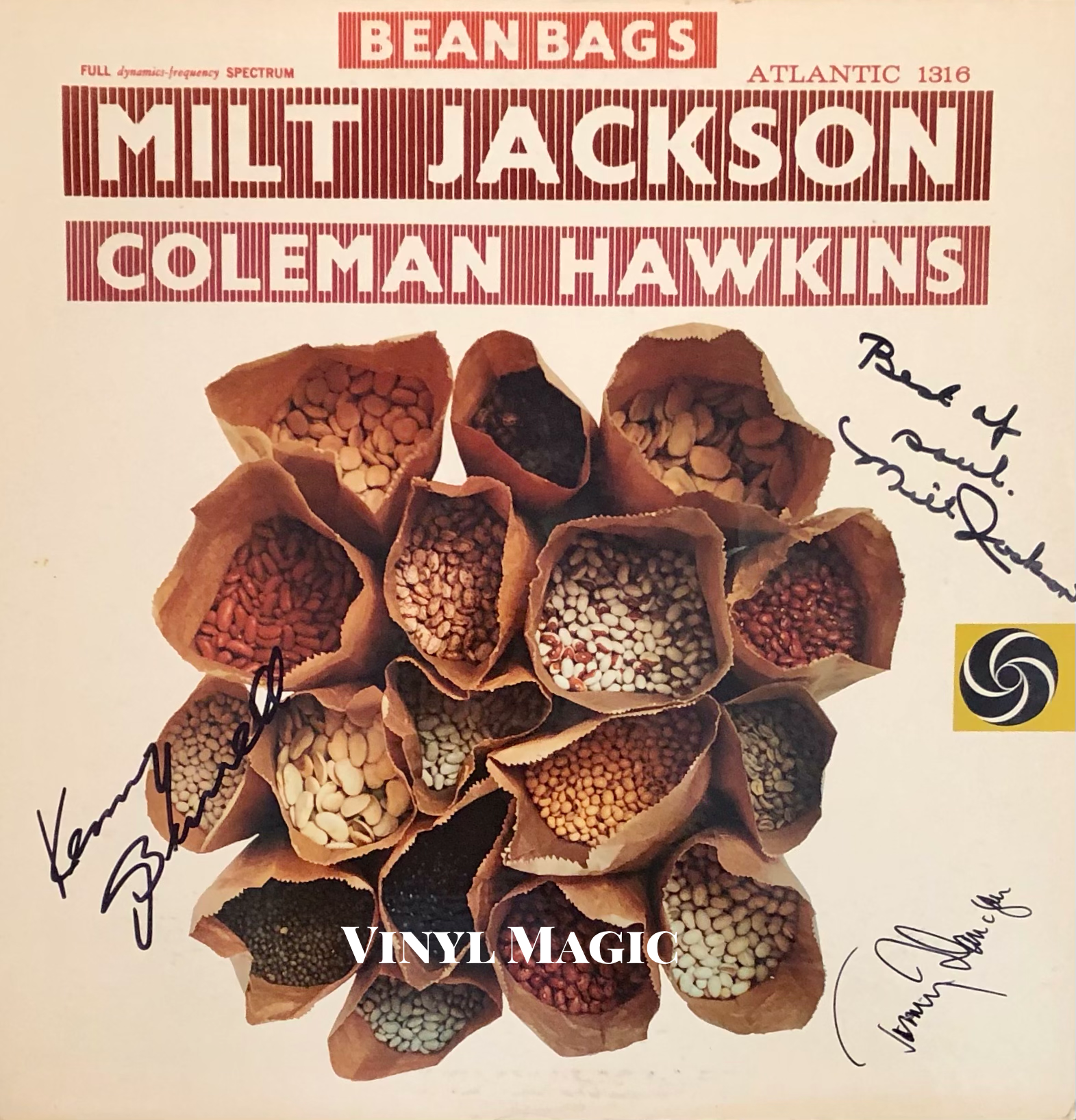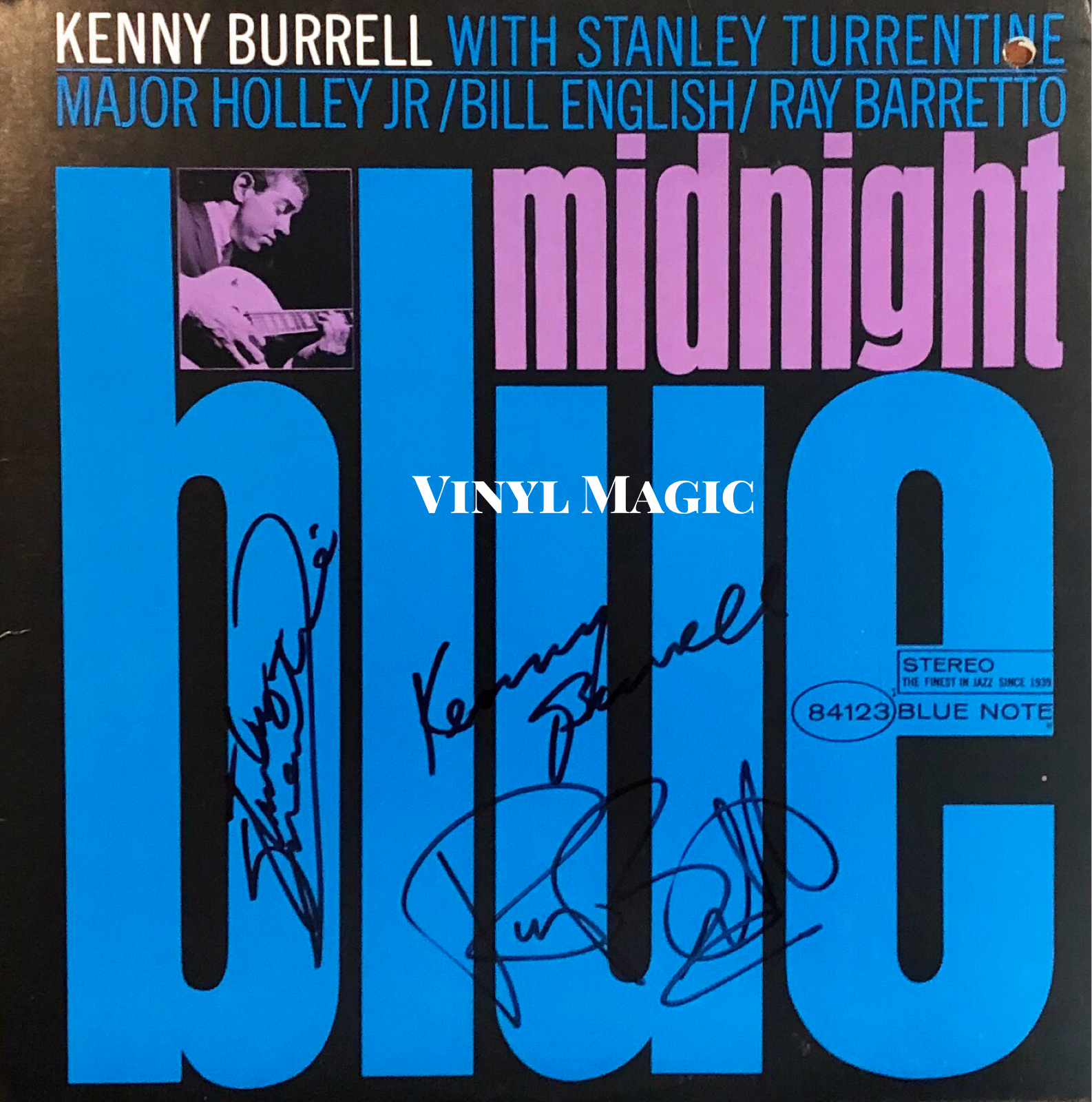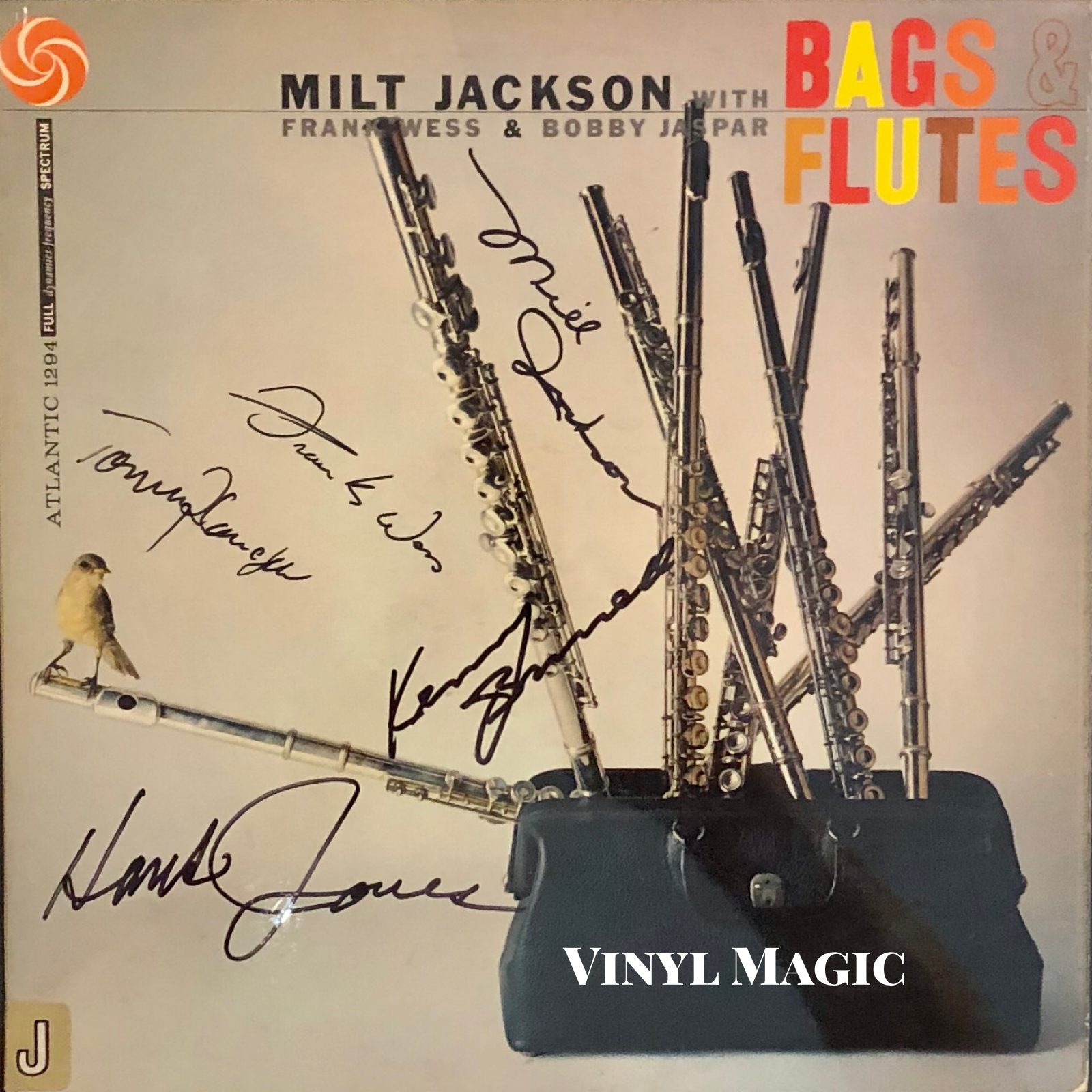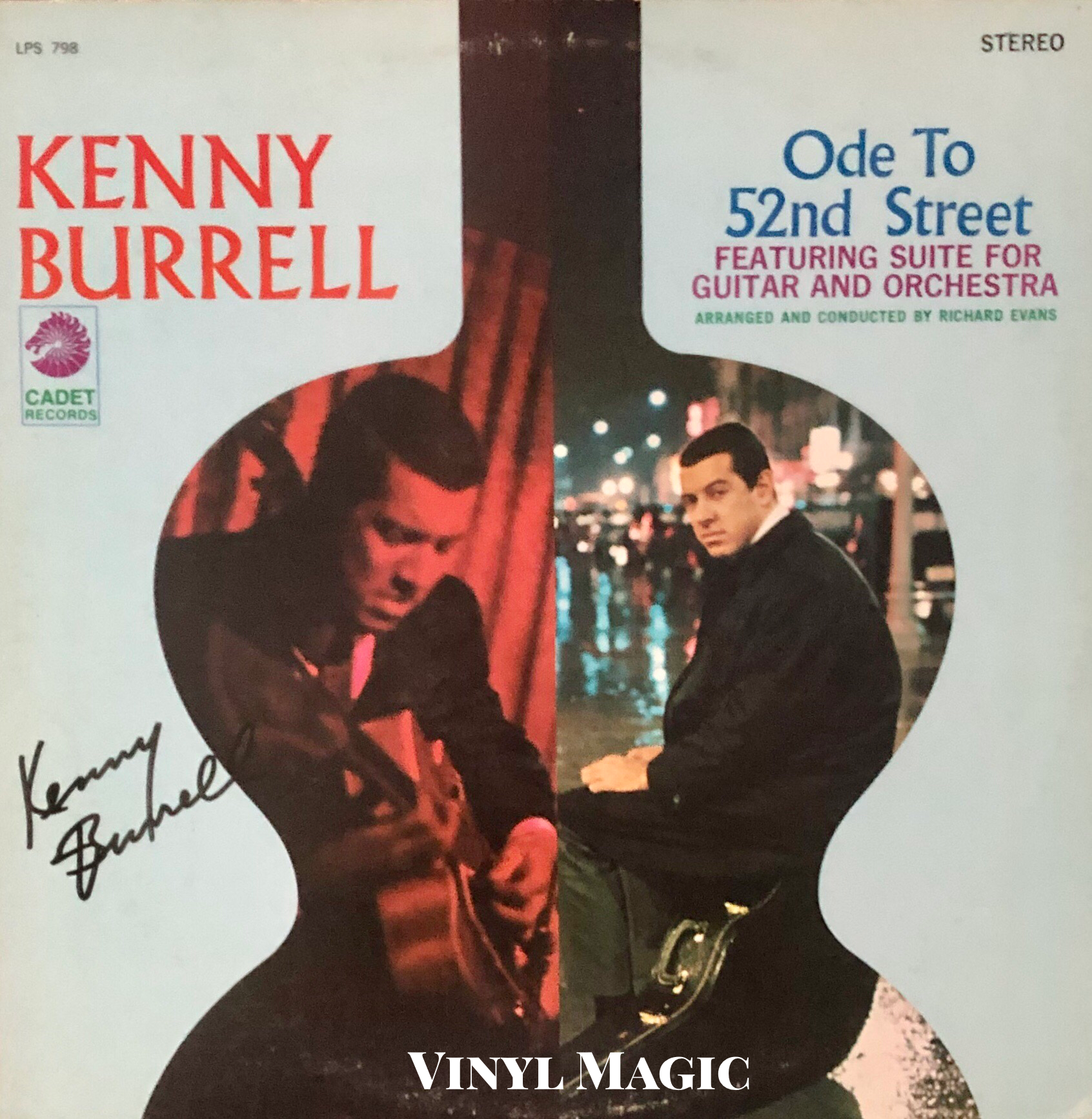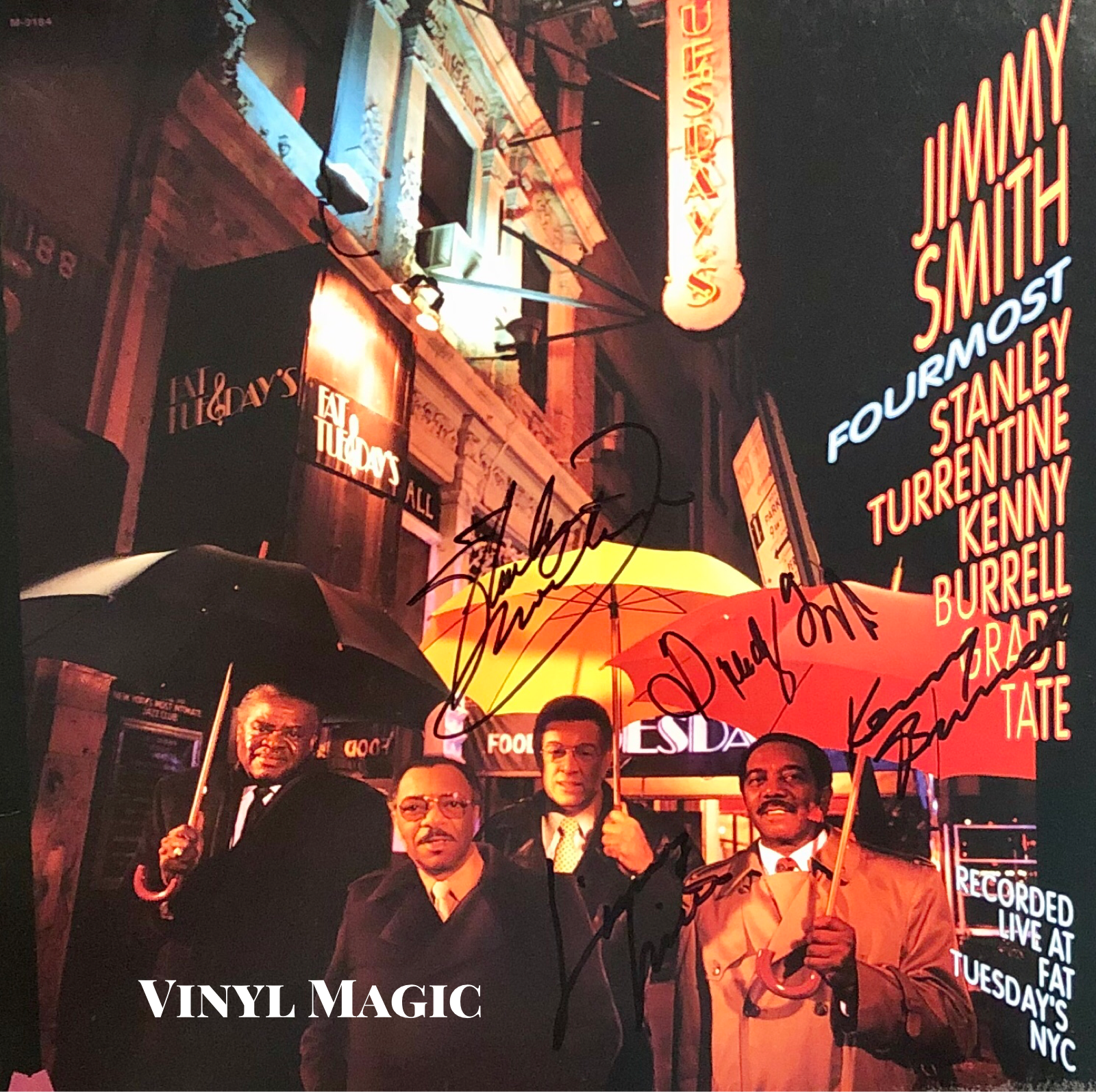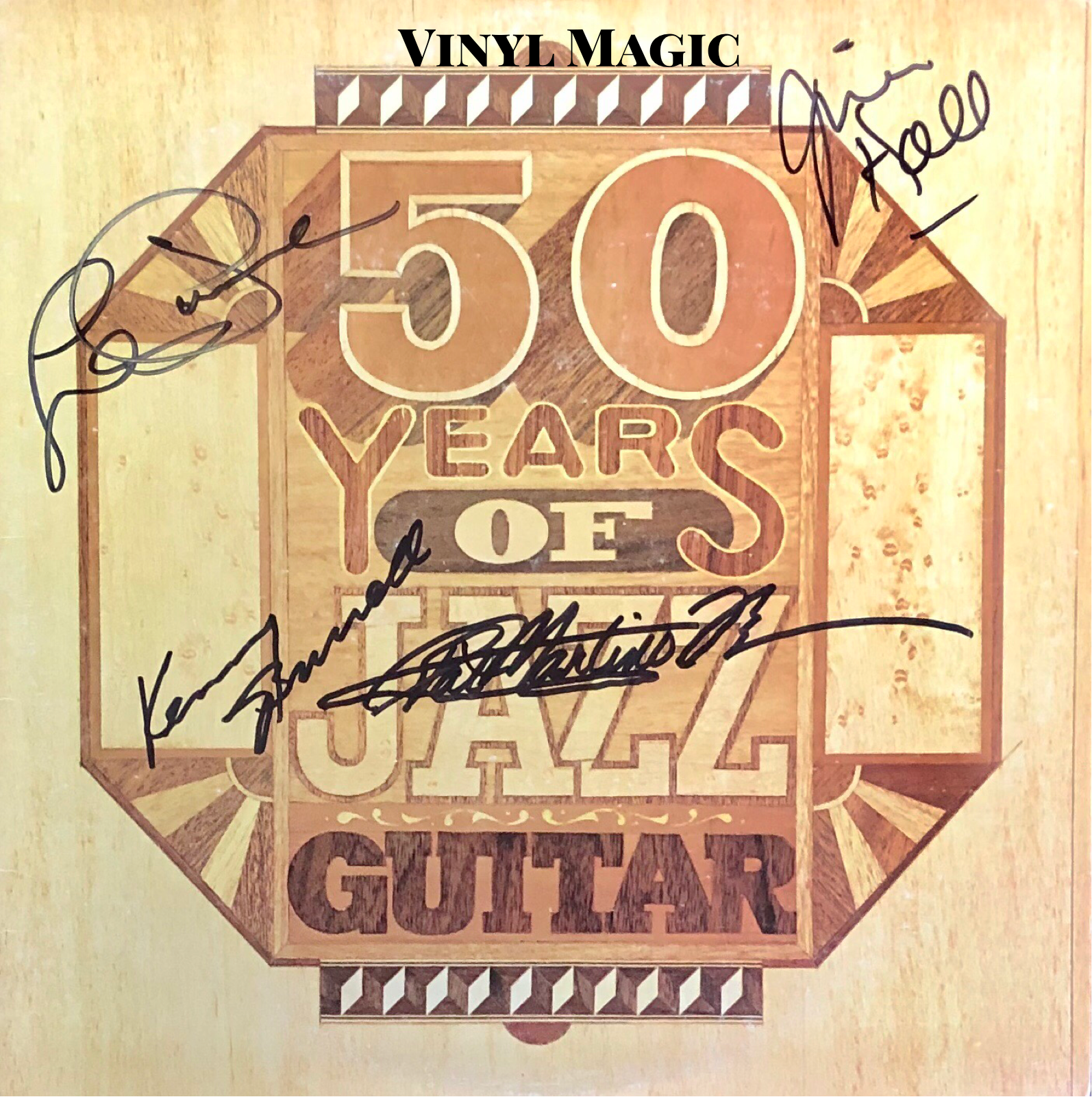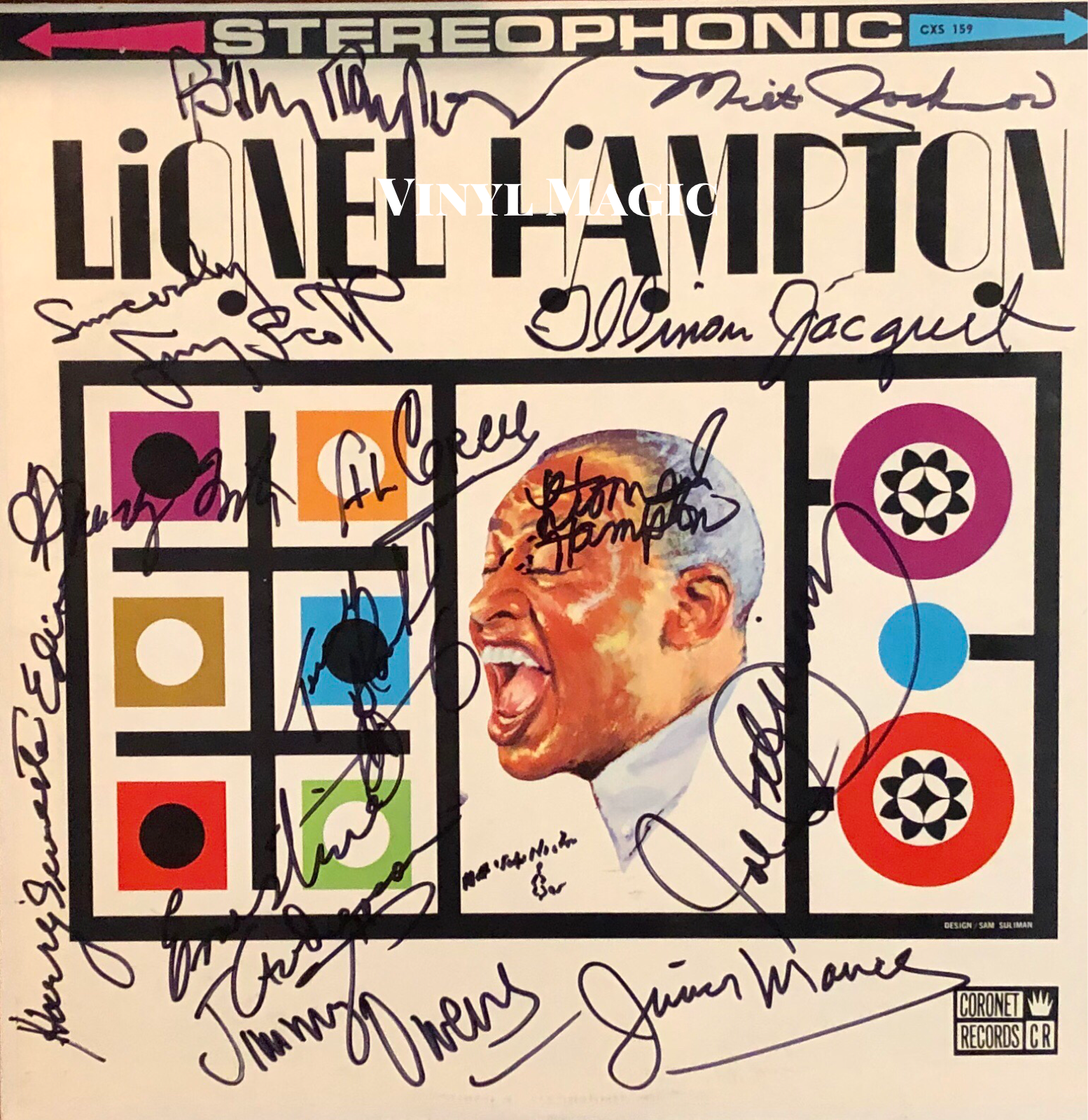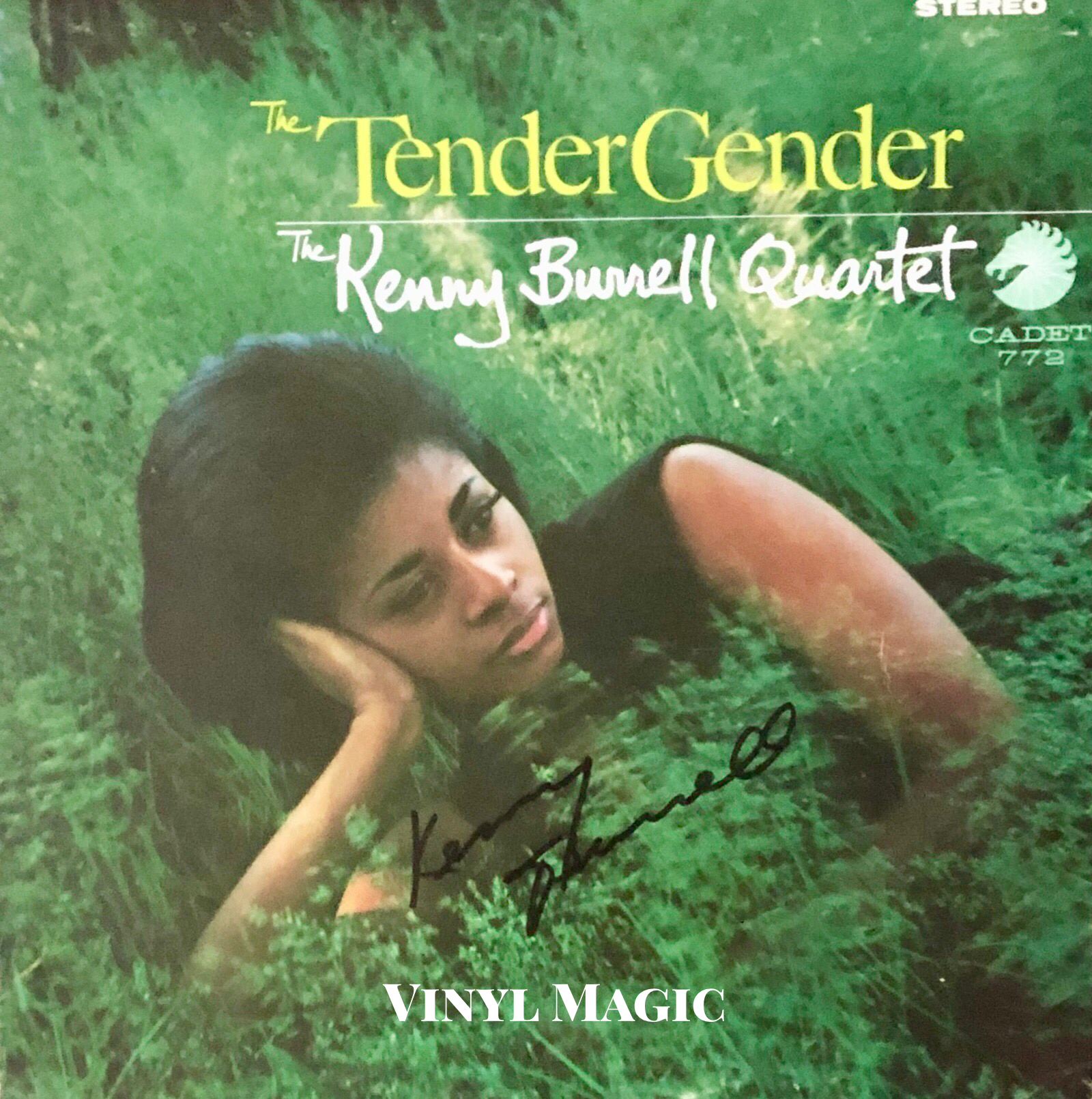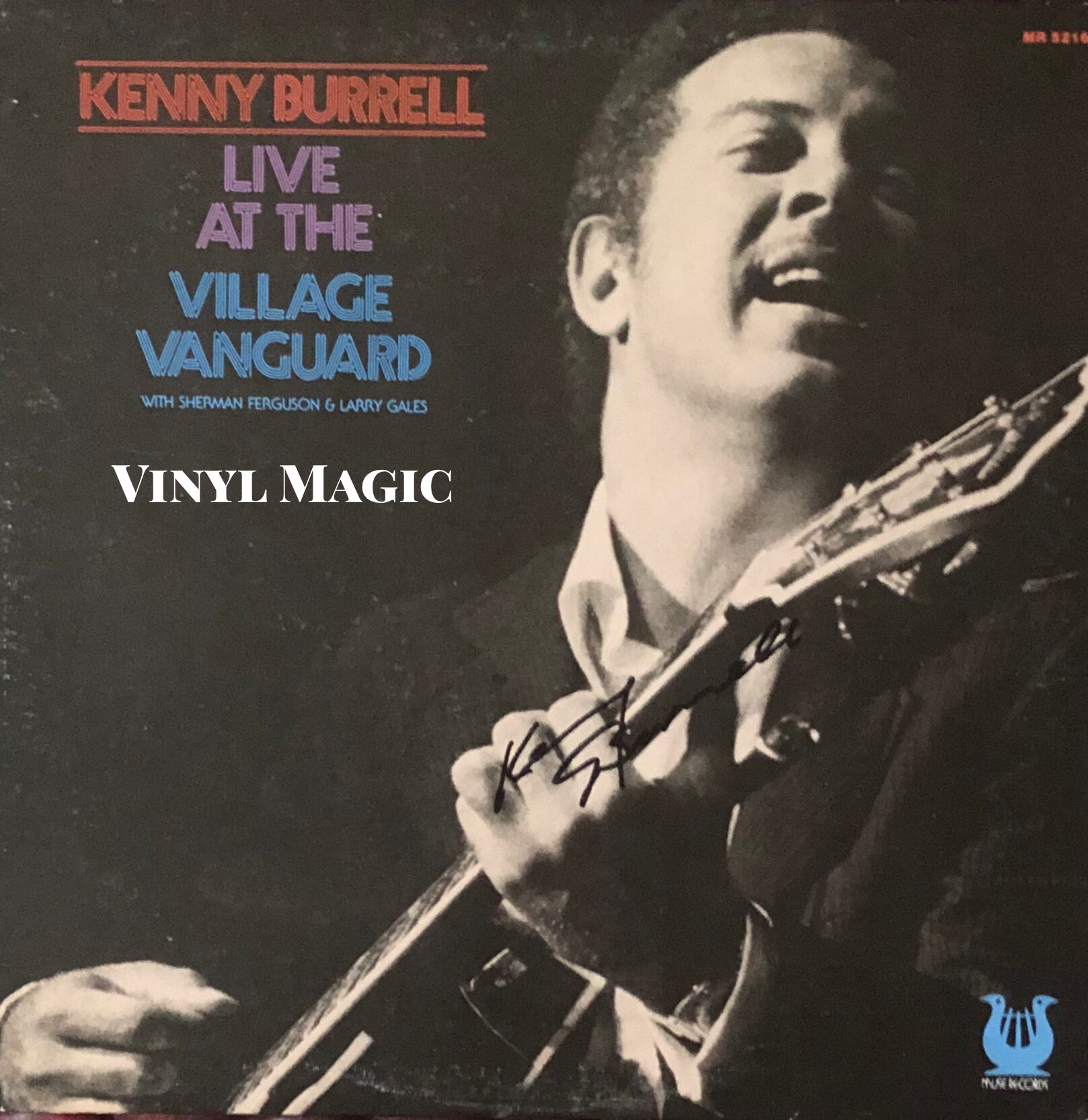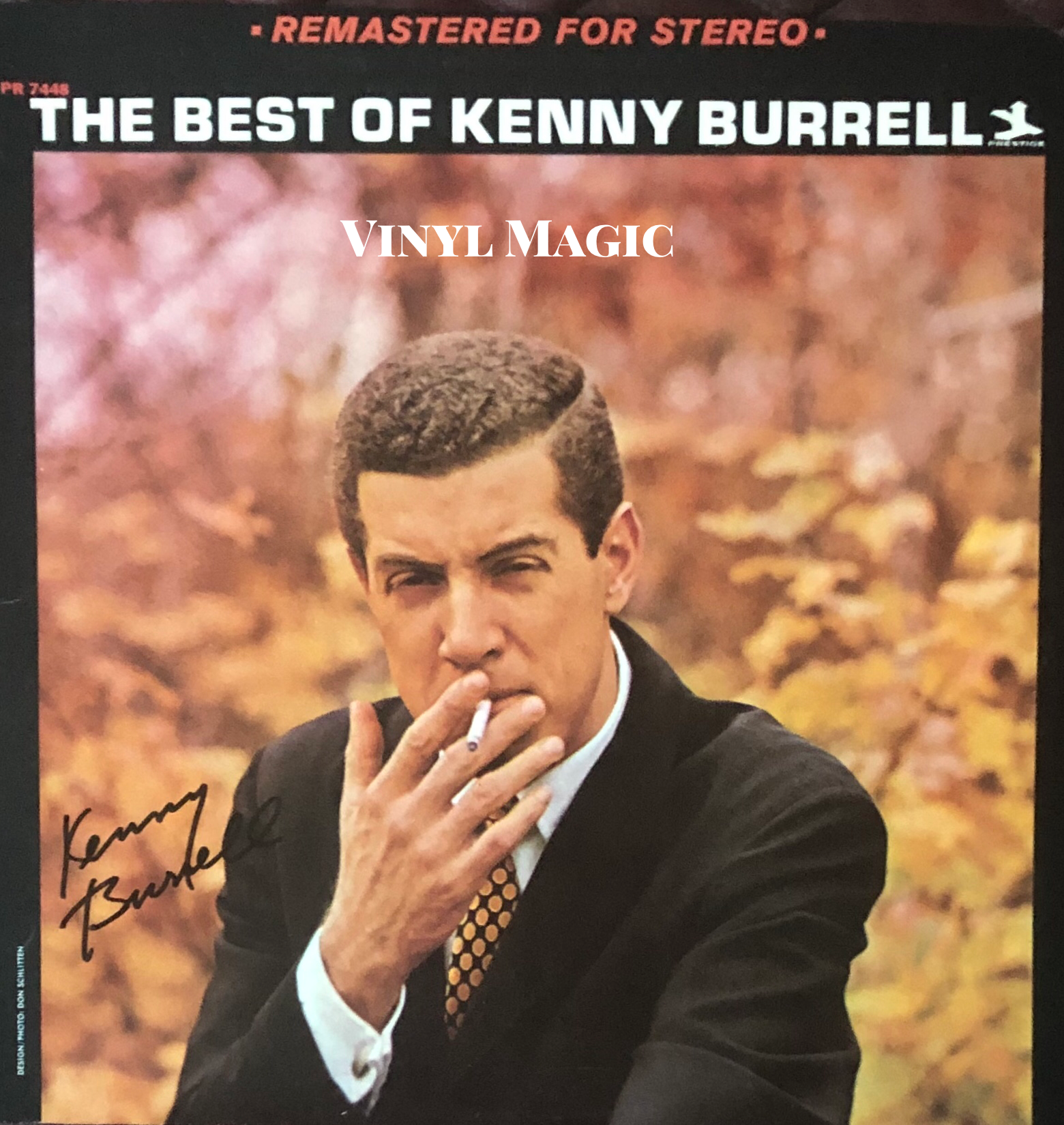Kenny Burrell and Me…
The blues is part of my heritage, part of my surroundings growing up in Detroit - on the radio, on records, in clubs, on the street. Like most guitarists, the blues was what I first learned to play. In my earliest jam sessions, we always played the blues. It felt natural. I will never deny that part of who I am. Some jazz musicians and some jazz fans feel the blues is so simple that they don't want to bother with it, that it's too primitive. I never felt that way. Time has proven me right. Throughout the history of jazz, people play the blues in many forms - fast, medium, slow, funky, sophisticated, in different meters and avant-garde. It's still blues.
Kenny Burrell
Blue Moods (1957 recordings, 1964 reissue) signed by Kenny
In blues and in jazz, the most important aspect of communicating your music is honesty. As humans, we get hung up on trying to be honest. Music is a place where you can do that freely. It's simple - just play what you feel. That doesn't cancel your intellect. You'll always know what the chords are, but that doesn't overwhelm what you're feeling. One of the reasons for my success, and others' through the years, is that I honestly try to play what I feel. It may not give you instant success, but I believe if you do it consistently, it will give you long-term success. It's spirit to spirit communication.
Kenny Burrell
All Day Long (1957) signed by Kenny, Donald Byrd, Tommy Flanagan, Frank Foster
That was what we called a "blowing session" put together by Prestige. I was happy to be in the circle of people called for that. We were each expected to bring in one or two songs. In the process, there's no time for rehearsals. You run down something once or twice and record it. I had to be on my toes, but was with great people, there were no problems. These were guys I knew - Trane, Tommy Flanagan, Paul Chambers, and Jimmy Cobb. We had a few originals and a couple of standards, nothing complicated.
The Cats (1958) signed by Kenny, Tommy Flanagan, Louis Hayes
For some reason, they made Trane and me co-leaders on the date. We didn't think in terms of who was the leader, we were just trying to make good music. The other record in that period was The Cats. I don't know who the leader was on that album. I enjoyed playing with Trane because there was always magic happening.
Kenny Burrell
The Sermon! (1959) signed by Kenny, Jimmy Smith, Lou Donaldson
We met at a jam session at the Bohemian Caverns. He was this dynamic new voice on the organ - nobody had heard anything like that before. I went to see him and he asked me to sit in. Alfred Lion, of Blue Note Records, was in the audience. He wanted to record me with Jimmy. I'd already recorded my first album (Introducing Kenny Burrell) for Blue Note. He thought it would make Jimmy's record more powerful.
Kenny meeting Jimmy Smith
Midnight Special (1961) signed by Kenny, Jimmy Smith, Stanley Turrentine
Jimmy and I made many records together. We had a natural affinity for each other's music, we just clicked. We both knew a lot of songs. we hardly ever had rehearsals and there was very little preparation. We just talked over a song, or he might mention a tune he wanted to play. We did most of it on the spot. It was the easiest partnership I've ever had. He always wanted me to play with him, if possible, which was rough on the guitar players in his working bands.
Kenny Burrell recording with Jimmy Smith
Blue Bash (1963) signed by Kenny, Jimmy Smith
I met her in 1952 or '53, when she traveled to Detroit to perform. I put together a band for her at the Rouge Lounge, a club in River Rouge, near Detroit. My group was popular in town, so we backed her a few times. I think we had Tommy Flanagan in the band. Billie liked the way I played and that I was sensitive to the lyrics. I tried to complement her and not get in the way of her music. We became friends and had mutual respect. When I moved to New York City in '56, I backed her several times, including at Carnegie Hall. Billie would come to hear me play at clubs, like Minton's in Harlem. I also played on a number of her records, including the last one Lady In Satin. I wasn't listed because I was a last minute substitute for Barry Galbraith, and it wasn't on the contract. I didn't play any solos, just rhythm and maybe a little passage here or there. Billie was a beautiful artist and, as we say in the business, she never sang a note she didn't mean. She influenced a lot of people, not only jazz singers but pop singers, including Frank Sinatra and Tony Bennett.
Kenny Burrell on Billie Holiday
Ellington Is Forever (1975) signed by Kenny, Ernie Andrews, Joe Henderson, Jon Faddis
He was ahead of his time and a leader in American music at its best. Elington's output was so varied and excellent, no one else compares with him. I learned many lessons from Ellington, but probably the most important one is to be yourself. Like Mae West said, be who you are because all the other bodies are taken.
Kenny Burrell on Duke Ellington
Ellington Is Forever Vol Two (1978) signed by Kenny, Gary Bartz, Joe Henderson, Sir Roland Hanna, Ernestine Anderson
Born in Detroit in 1931, Kenny Burrell was raised in a very musical family. His mother played piano and sang in the church choir, his father played banjo and ukulele, and his older siblings all played instruments as well. The saxophone was his first love, yet the shortage of metal during World War II precluded that purchase and pursuit, so Kenny began playing guitar at age twelve on a cheap, $10 cast off. This was undoubtedly one of the greatest returns on investment (ROI) in musical history!
On View At The Five Spot (1960) signed by Kenny
Kenny's early influences were the fleet fingered stylings of Charlie Christian of the Benny Goodman band, Oscar Moore of the great Nat King Cole trio, and Django Reinhardt, the mercurial gypsy guitar genius. In those days, there was a fertile and vibrant music scene thriving in Detroit, with jazz and blues artists performing regularly, the perfect environment for a young musician like Kenny to absorb all that music and, occasionally, sit in.
Blues: The Common Ground (1968) signed by Kenny
At Wayne State University (conveniently located in Detroit), Kenny studied composition and music theory and, while there, he helped found the New World Music Society along with his fellow Detroit born brethren Pepper Adams, Donald Byrd, Elvin Jones and Yusef Lateef, all future jazz stars and leaders. While still in college, Kenny played on his first recording session with Dizzy Gillespie in 1951, "Yes, I was nineteen. We met at the Club Juana in Detroit, and I played with him for one month. He needed a quick replacement and I got the call, probably a recommendation from Milt Jackson. It was the first time Dizzy used a guitar instead of a piano to play back-up chords, solos and ensemble lines. He continued to use that format in some of his ensembles for the rest of his career. I didn't realize at the time that I was helping to create a standard for Dizzy's idea."
Jazz For Playboys (1957) signed by Kenny, Frank Wess
Kenny was also blessed to sit in with Miles Davis and Charlie Parker when they were passing through, "They would come through and they would have local bands play with them, and they would oftentimes pick me to be in the local band to back them up. Charlie Parker was very encouraging when he heard me. He said, 'Yeah man, you sound good.' To a youngster in his teens, when somebody like Bird says that, it's very encouraging." After touring with Oscar Peterson (replacing Herb Ellis who took a much needed health sabbatical), Kenny felt it was time to move to New York City to pursue his musical dreams. Kenny was hanging out with his friend Tommy Flanagan, a gifted pianist, and "I decided I was going to go and I said, 'You want to go?' And he said 'Yeah", so we just got in my car and we came." And the two Detroit bred brothers became sought after session men in the ensuing years while participating in some of the most historic collaborations and recordings in the annals of Jazz history.
Bean Bags (1958) signed by Kenny, Tommy Flanagan, Milt Jackson
The breadth and depth of Kenny's accomplishments on guitar is simply staggering. Not only did he play and record with Louis Armstrong and other jazz titans - Duke Ellington, Chet Baker, John Coltrane, Bill Evans, Dizzy Gillespie, and Colemn Hawkins - but he also supplied his deft and tasty chops to singers as disparate as Tony Bennett, James Brown, Ray Charles, Aretha Franklin, Billie Holiday, B.B. King, Miriam Makeba, and Maria Muldaur among countless others. It is probably easier to list who Kenny didn't play with in his storied career than it is to list the musicians and the thousands of sessions he was involved in. Even Kenny doesn't really know!
Midnight Blue (1963) signed by Kenny, Ray Barretto, Stanley Turrentine
As he once said, "When I was in New York from 1958-63, I did an average of six sessions a week. That's a conservative estimate, I sometimes did two or three a day - at least 1,560. Those are just the sessions, my name was on maybe 10 percent of them. Usually, at a session, we made four records. I'm not counting jazz records or my own albums. I was like a doctor, constantly on call. After 1963, it tapered off, I did less studio work and more of my own recordings. Still, I enjoyed the studio work, it made me feel good at my craft. But it did hurt in some ways because I didn't have enough time to practice and concentrate on my music. That's why I took the jobs in Bye, Bye Birdie and other shows. It was steady work and after a couple of weeks, you hardly need to look at the music. It allowed time to practice, think conceptually, and write music for albums like Midnight Blue and Guitar Forms.”
Guitar Forms (1965) signed by Roger Kellaway
In addition to his ubiquitous session work, Kenny has also released more than a hundred recordings as a leader, including some of the most important and influential. Among them, A Night At The Village Vanguard (also re-released as Man At Work in 1966), was one of the first jazz guitar trio albums ever recorded in 1959. Kenny remembered the circumstances, "It started with an experiment in the early '50s at a small club in Detroit with a tiny space that only allowed for that size trio. I wanted to try the format again in New York in '59. Max Gordon, who ran the Village Vanguard, didn't like the idea of working without a piano at first. He always had a great piano there, but we were friends and I'd played there many times, so I asked him to give it a chance. He gave me one night, a Monday night or something. I wanted it to be as good as possible, so I got two of the best guys, Roy Haynes and Richard Davis. Max liked it and gave us two weeks - a pretty long time by today's standards. The second week, we recorded live for Cadet. This was a dream fulfilled because it had been in my mind for a long time and I felt I could do it well. In a guitar trio, the focus is to think about the possibilities, not what's missing. If you do, things will flow... but I do love the format. In retrospect,it not only affected jazz players but also rock players." Indeed, rock guitar deity Jimi Hendrix (to whom we must all bow down and pledge fealty!) was once quoted as saying, "Kenny Burrell, that's the sound I'm looking for."
Man At Work (1959 recordings, 1966 reissue) signed by Kenny, Richard Davis, Roy Haynes
Kenny's reach in academia is equally broad and impressive. What began as a part time course at UCLA on "Ellingtonia" in 1978, became a full time teaching curriculum when Kenny became the Founder and Director of Jazz Studies in 1996. In 2013, Kenny remembered, "I began teaching at UCLA in 1978. In the winter quarter, I was asked to teach by the director of African-American Studies... They wanted to do something with jazz as a natural outgrowth of the program. I couldn't do it full-time with my performing, recording and traveling schedule, but I did agree to teach part-time. My inclination was to do a class on Duke Ellington. To me, he was the most successful jazz musician, jazz and beyond. It worked, and now they're teaching Ellington classes all over the world. I had the first one and called it Ellingtonia, an umbrella phrase for all its music. But it's not just about music, It's about a style, a persona, African-Americanism, his philosophy and influence. I still teach that class now, thirty-five years later."
Bags & Flutes (1957) signed by Kenny, Milt Jackson, Tommy Flanagan, Hank Jones, Frank Wess
In his role as Director, Kenny was able to enlist Herbie Hancock, Billy Higgins, Harold Land, Gerald Wilson and many others as faculty members, probably the best jazz faculty assembled anywhere. Kenny was also instrumental in helping secure a $30 million bequest by Herb Alpert, noted musician, record label owner (the A in A&M Records!) and philanthropist. Yes, the Tijuana Brass were very, very good to Herb, and, by extension, all the wonderful jazz students who were nurtured by Kenny and his staff. Current Blue Note saxophone star Kamasi Washington is just one of the talented graduates to continue in the jazz tradition shaped by Kenny. Though he retired in 2016 after a nearly forty year association with UCLA, Kenny leaves an enormous artistic and cultural footprint.
Much In Common (1964) signed by Kenny, Milt Jackson, Ray Brown, Albert Tootie Heath, Hank Jones
I saw Kenny many times over the years - Blues Alley, Blue Note, Dizzy's Club at Lincoln Center and the Kennedy Center to name a few - and he was always such a dynamic performer. Unfortunately, as his academic responsibilities grew, he toured less frequently, but I was fortunate to see him one last time at Dizzy's in New York City in 2008, his first gig in New York in more than a decade. He did not disappoint. His accompanists were brilliant: pianist Benny Green, bassist Peter Washington, and drummer Clayton Cameron. Highlights included the Latin rhythms of Chano Pozo's "Tin Tin Deo", a smoking "Blue Bossa" written by the great Kenny Dorham, and, of course, Ellingtonia: a gorgeous "In A Sentimental Mood" and Kenny's tribute to his mentor, his evocative solo guitar on his original composition "Be Yourself."
Ode To 52nd Street (1967) signed by Kenny
After the show, I had a visit with Kenny in his dressing room. He was such a gentleman. He had the manner and mien of a college professor or a distinguished man of letters, which is exactly what he was. When he signed The Cats, he said, "I see you have Tommy (Flanagan) on here, we go back a long, long way. What a great friend and talent he was, I miss him." Of Jimmy Smith, with whom he played on numerous recordings, "I had a lot of fun with Jimmy. What a great musician." When Kenny signed Midnight Blue, he told me, “I loved playing with Stanley (Turrentine), he had such a big, warm sound, and Ray (Barretto) added so much to our recording.” Released in 1963, Midnight Blue features six tunes written by Kenny and one standard, “Gee Baby, Ain’t I Good To You.” This might be my favorite Kenny Burrell recording, and the stunning Reid Miles design with the Francis Wolff photograph influenced the design on fellow musicologist Elvis Costello’s Almost Blue. I thanked Kenny for his time, generosity and, especially, his prodigious music.
Steamin’ (1963) signed by Kenny, Frank Wess
Fourmost (1990) signed by Kenny, Jimmy Smith, Grady Tate, Stanley Turrentine
Unfortunately, Kenny has endured some very difficult health issues of late and can no longer play guitar. It is truly a shame and I wish him peace and blessings. However, his legacy of untold recordings leaves a wealth of musical riches and influence across many genres. Not a bad return on a cheap $10 guitar!
50 Years of Jazz Guitar (1976) signed by Kenny, Jim Hall, Pat Martino, Les Paul
Lionel Hampton (1962) signed by Kenny, Billy Taylor, Milt Jackson, Jimmy Scott, Illinois Jacquet, Harry Sweets Edison, Al Grey, Grady Tate, Lionel Hampton, Ernestine Anderson, Jimmy Owens, Junior Mance, Joe Williams, Milt Hinton
North, South, East…Wess (1956) signed by Kenny, Frank Wess, Frank Foster, Benny Powell
The Tender Gender (1966) signed by Kenny
Choice Kenny Burrell cuts (per BKs request)
https://www.youtube.com/watch?v=OlfWcvJKvNo
“Freight Trane” with John Coltrane 1958
https://www.youtube.com/watch?v=FZGHuNdHCjY
“Tommy’s Tune” with Tommy Flanagan, John Coltrane 1958
https://www.youtube.com/watch?v=xOwQmNmhjJo
“I Never Knew” with John Coltrane 1958
https://www.youtube.com/watch?v=mP0flneNfaQ
“Chitlins Con Carne” Midnight Blue 1963
https://www.youtube.com/watch?v=CtI_p3Sak5M
“Fever” Blue Bash with Jimmy Smith 1963
https://www.youtube.com/watch?v=hDJ6d5dvs8k
“Satin Doll” Organ Grinder Swing 1965
https://www.youtube.com/watch?v=p1ipftv39YU
“All Blues” live in Paris 1969
https://www.youtube.com/watch?v=3bh63URTvR8
“Stormy Monday Blues” Stormy Monday with Richard Wyands 1974
https://www.youtube.com/watch?v=ybfh7Kc8zLg
“In A Mellow Tone” live with Ron Carter 1990
https://www.youtube.com/watch?v=wmn8qGn5zt8“
“A Child Is Born” live with Bill Evans 1978
https://www.youtube.com/watch?v=SaUCSAEToaQ
The Jumpin’ Blues” live with Jimmy Smith, Grady Tate, Stanley Turrentine 1990
https://www.youtube.com/watch?v=BsLp2S4cLo4
“Be Yourself” live at Dizzy’s, NYC 2008
https//www.youtube.com/watch?v=Um1lA9m4wL0
”Chitlins Con Carne” Stevie Ray Vaughan 1991
Live At The Village Vanguard (1980) signed by Kenny
The Best Of Kenny Burrell (1966) signed by Kenny
